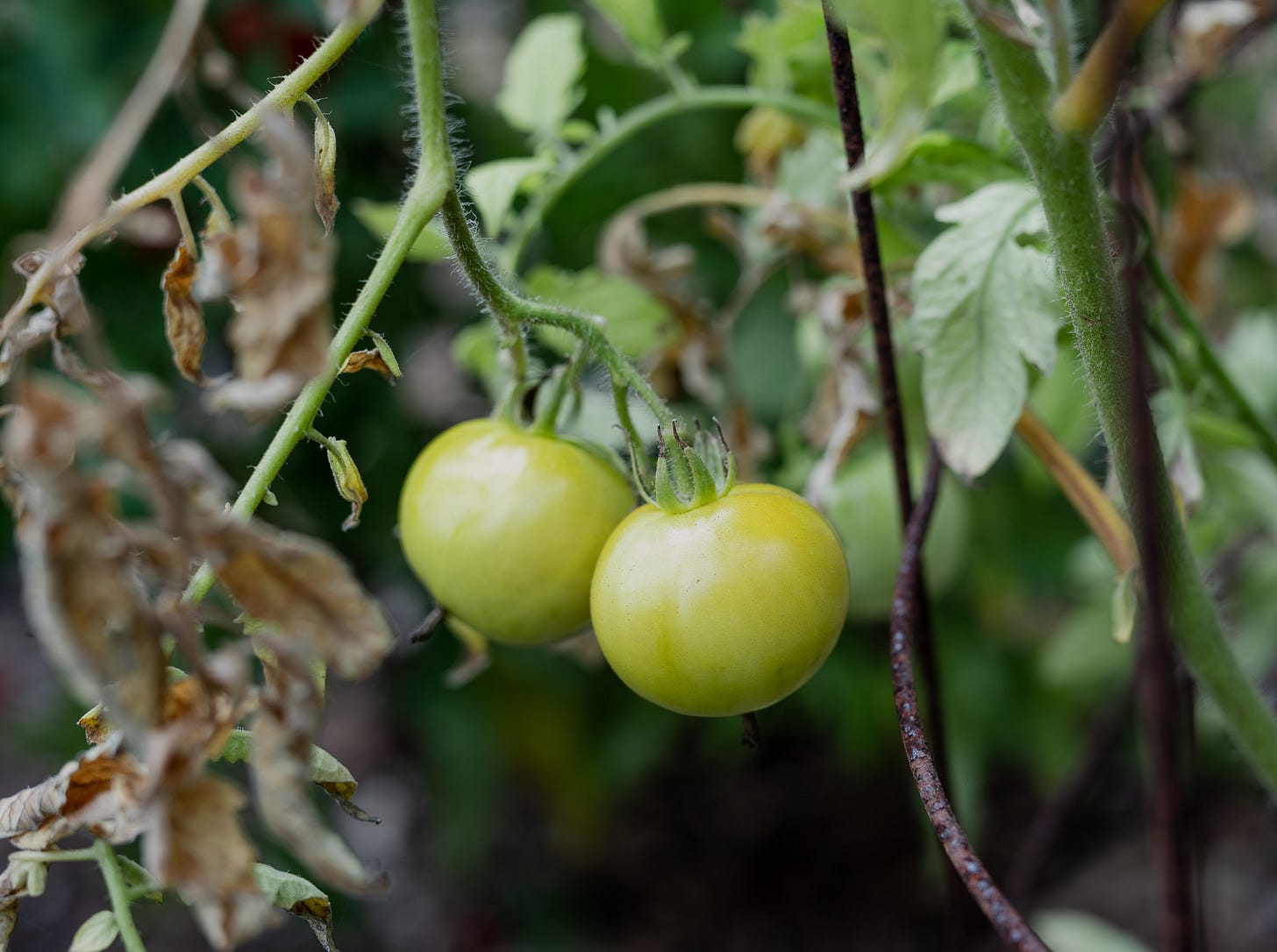Tomatoes in “Brrrrkley”
Mark Twain’s quip "The coldest winter I ever spent was a summer in San Francisco” also applies to Berkeley directly across the bay. To us locals it’s “Brrrrkley”; come evening, without fleece or wool you’re out of luck. Such as it is, you can forget about growing typical heat-loving summer vegetables. Onions, garlic, pole beans, peas, and cole crops all flourish in my garden’s bayside climate. But it’s impossible to grow anything that resembles a “beefsteak” tomato. In July, at what should be the height of the tomato growing season, the fog blows in nearly every afternoon. The sun pokes through the next late morning, thankfully drenching the midday hours. But just as you’re thinking about dinner on the patio, the grey miasma makes another entrance. Full-sized tomatoes love the sun and the kind of heat you find in muggy Kansas or Jersey. But with temperatures that top out on average at 72F and regularly plummet 20 degrees, tomatoes not suited to such swings just stall out in Berkeley.
Tomato Cultivars
I have tried to grow the recommended short to mid-season varieties such as “San Francisco Fog,” “Stupice,” “Celebrity” and many of the heirloom varieties. But none hold a candle to “Early Girl,” a deep red flavor bomb developed in France in the ‘70s and known for its exceptional performance as a dry-farmed crop in California’s coastal zones.
Early Girl tomatoes became controversial among farmers, sustainability advocates, and home gardeners when the rights to their seeds were taken over in 2005 by the Monsanto Corporation, the patent troll of seed stocks. Early Girl is a hybrid of two different parent plants. This means that a farmer cannot save the seed for replanting but must purchase them anew each season. For many, the Monsanto connection either muddied its pedigree or was an outright deal breaker. However, two successful offshoots have been developed from the original plant since then. “New Girl” came on the market as a promising alternative. Later a California organic farmer did the painstaking work of growing out successive plantings of the seeds of Early Girl and selected for their desirable traits. The result was “Dirty Girl” which expresses some of the best qualities of the parent plant. I have dry-farmed both of these newbies alongside Early Girl and with some variations in size and conformation, the differences are hard to parse in a blind tasting. All set intensely sapid fruit on bushy vines. The fruit is smallish, compact, and has a noticeably thick skin that cracks at first bite. Starve the plant of water and it gives everything it’s got, delivering concentrated sweetness balanced with a bright acid nerve and salty minerality. On the sugar scale, the juice of my ripe fruit measures 12%, half as sweet as the ripest grape (I am reminded that tomatoes are botanically a fruit…) and twice as sweet as tomatoes commonly found in the market.
Early Girl and her offspring are “indeterminate”—they bear continuously over a season, flowering and fruiting until temperature and diminished sunlight arrest any further growth. I leave my plants in the ground into the better part of October. But these last yields are not red ripe. Rather, they remain just blushed or entirely green on the vines and ripen no further.
Sott’olio
But what to do with green tomatoes? In the raw, you’ll notice that they are about as appealing as sour grass. Because of this, most applications are geared toward taming their acidity by sugaring them heavily—filling a pie or turning them into jam or chutney; battering and frying them to soften their tough skin and pulp, or enhancing their natural texture and flavor in a pickle. Since there is always more than I can manage to use in the kitchen, I prefer to preserve them by the Italian method called “sott’olio” meaning ‘under oil’. The great advantage of this method is that it maintains the native flavor of just-picked vegetables all year long. As a preservation method, it relies upon salting, removing water, acidification, and submersion under a protective layer of oil. All of these steps provide hurdles against spoilage. Just the same, it’s important to keep food safety in mind when storing vegetables in oil. Low-acid foods can be a source of bacteria found in soil, water, and air and the low-oxygen environment is ideal for the growth of certain dangerous bacteria. As long as there is sufficient acidity in the mixture, sott’olio vegetables and their seasonings may be stored at room temperature. “Sufficient” means acidity less than 4.6 on the pH scale. Preserving green tomatoes, however, doesn’t require a pH meter to confirm the level. Fortunately, green tomatoes have sufficiently high acidity to ensure their food safety in the sott’olio process but garlic, oregano (fresh or dry), and peperoncino should spend the night in a vinegar bath to acidify them before being added.
Traditional green tomato sott’olio recipes from Puglia or Calabria call for just a few added ingredients: salt, vinegar, garlic, dry oregano or mint, fresh hot pepper (pepperoncini), and extra virgin olive oil. The better the vinegar the better the flavor. Unflavored white wine vinegar with at least 7% acidity is best. Distilled vinegar leans toward harshness. Extra virgin oil may appear as a splurge considering how much is needed to submerge the tomatoes. However, once the tomatoes are consumed the leftover oil may be used in salad dressings, marinades, and any number of cold sauces.
Here’s the blueprint
Keep reading with a 7-day free trial
Subscribe to Notice! to keep reading this post and get 7 days of free access to the full post archives.






